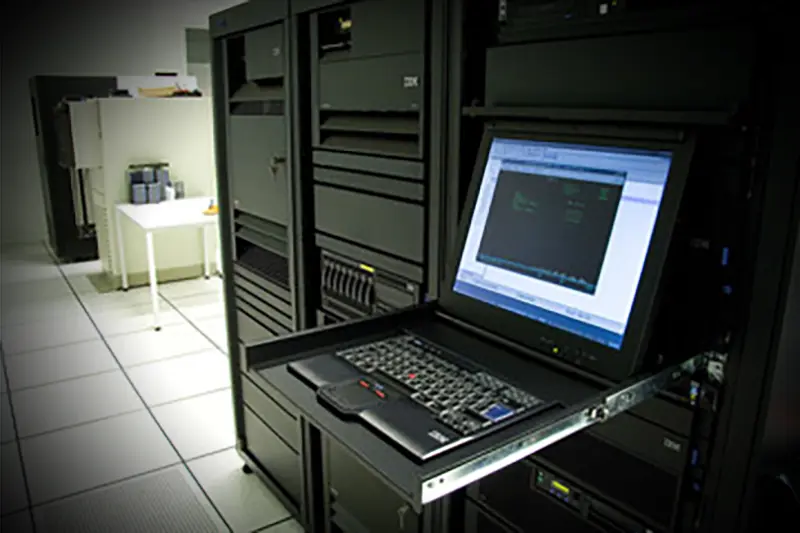AS400 Software - A Comprehensive Guide
Explore the capabilities and applications of AS400 software. Learn how this powerful midrange computer system revolutionizes critical business functions. Discover its uses in ERP, database management, custom application development, and more.
The AS400 Legacy
AS400 software, also known as IBM i, is an operating system and software platform developed by IBM for their midrange computers, originally introduced in 1988. The platform was initially known as the AS/400 (Application System/400) and later rebranded as the iSeries, System i, and ultimately IBM i.
AS400 software is designed to run on IBM’s midrange servers, which are known for their reliability, scalability, and ease of management. It is a highly integrated and versatile platform that supports a wide range of business applications and services, making it popular in various industries, including finance, manufacturing, retail, healthcare, and more.
In addition to many Fortune 500 companies, more than 100,000 other companies use IBMi on power systems as recently as 2022. (Source: integrative systems)
Despite its age, AS400 software remains a viable and popular platform for businesses with a significant investment in legacy applications, and it continues to evolve to meet the changing needs of modern businesses.
Origins and History of the AS400
The IBM AS400, now known as IBM iSeries or IBM System i, has its origins in the late 1980s. It was introduced by IBM in June 1988 as a successor to their System/3X series. The AS400 was designed to be a versatile, reliable, and user-friendly midrange computer system targeted at small and medium-sized businesses, as well as large enterprises.
The development of the AS400 was a significant leap forward in computing technology at the time. It integrated a number of innovations including a powerful chipset, advanced operating system (OS/400), and a unique architecture that allowed for seamless integration of various applications.
One of the key features of the AS400 was its commitment to backward compatibility, meaning that applications written for earlier IBM systems could run on the AS400 without modification. This ensured a smooth transition for businesses upgrading their computing infrastructure.
Over the years, the AS400 platform evolved with advancements in hardware and software. It became known for its reliability, security features, and robustness, making it a popular choice for mission-critical applications across various industries.
In the early 2000s, IBM rebranded the AS/400 as the IBM eServer iSeries, and later as IBM System i. Despite several rebrandings, the core architecture and principles of the AS/400 platform remained intact, demonstrating its enduring value in the world of enterprise computing.
Key Characteristics of AS400 Software
1. Integrated Architecture: One of the defining features of AS400 software is its integrated architecture. It combines a robust database system, a high-level programming language (RPG), a comprehensive security model, and various middleware components. This integrated approach simplifies development, deployment, and maintenance of business applications.
2. Reliability and High Availability: AS400 servers are known for their exceptional reliability and built-in redundancy, allowing them to provide high availability. The platform offers advanced features like journaling and commitment control to ensure data integrity and minimize downtime.
3. Security: IBM i is renowned for its robust security model. It includes features like user authentication, object-level security, role-based access control, and encryption to protect data and prevent unauthorized access.
4. Scalability: AS400 software can scale to meet the needs of growing businesses. It can handle a wide range of workloads, from small businesses to large enterprises, without sacrificing performance.
5. Easy Management: The platform is designed to be user-friendly and easy to manage. It provides a graphical user interface (IBM Navigator for i) and command-line interface (OS/400) to manage various aspects of the system.
6. Legacy Support: AS400 software has a long history, and many organizations have developed critical applications on the platform. IBM i continues to offer backward compatibility to ensure that legacy applications can run on newer hardware and software versions.
7. Support for Multiple Workloads: IBM i can run a diverse set of workloads, including transaction processing, batch processing, web serving, and more. It supports various programming languages, including RPG, COBOL, Java, C, and PHP.
8. Virtualization and Partitioning: IBM i provides virtualization capabilities that enable multiple logical partitions (LPARs) to run on a single physical server. This allows organizations to consolidate workloads and optimize resource utilization.
9. Advanced Query and Reporting: The platform includes a powerful query and reporting tool called Query/400, which allows users to extract and analyze data from the integrated database easily.
10. Modernization and Integration: IBM i has evolved over the years to embrace modern technologies and integration with other platforms. It supports web services, RESTful APIs, and modern development frameworks to facilitate integration with newer applications and technologies.

What is the Difference Between IBMi and AS400 Software?
IBM i and AS/400 are closely related terms, but they refer to different aspects of the same computing platform. Here are the distinctions between IBM i and AS/400:
AS/400:
- Historical Term: AS/400 refers to the original line of midrange computers introduced by IBM in 1988.
- Hardware Line: It was the name of the hardware line that included models like AS/400 Model 9406.
- System/38 and System/36 Compatibility: AS/400 was designed to be compatible with applications written for its predecessors, the System/38 and System/36.
- Legacy Term: While still used informally, “AS/400” is now considered a legacy term as IBM has rebranded its hardware multiple times.
IBM i:
- Current Operating System: IBM i is the current operating system (OS) that runs on IBM’s midrange hardware, which evolved from the AS/400 line.
- Continuation of AS/400: IBM i can be considered as the modern iteration and evolution of the original AS/400 operating system (OS/400).
- Ongoing Development: IBM i has seen continuous development and enhancement, making it a modern and robust operating system.
- Compatibility with Legacy Apps: IBM i retains compatibility with applications written for earlier AS/400 systems.
In summary, AS/400 primarily refers to the original line of hardware introduced in 1988, while IBM i refers to the current operating system that runs on the evolved hardware platform. IBM i is the modern, updated version of the operating system that was initially introduced as OS/400 with the AS/400 hardware. Both terms are often used interchangeably, but it’s important to understand the context in which they are being used.
Is AS400 a Mainframe?
Yes, AS/400 is a family of midrange computer systems that are considered a type of mainframe. It was originally introduced by IBM in 1988 and is known for its robustness, reliability, and scalability. The AS/400 platform is designed for businesses and organizations that require a powerful and secure computing environment for critical applications and data processing.
While AS/400 systems are not classified as “big iron” mainframes like the larger IBM Z series, they share many characteristics with mainframes, such as a high level of reliability, security features, and the ability to handle large workloads. AS/400 systems have been widely used for tasks like enterprise resource planning (ERP), database management, and various other business applications.
What is an AS400 Used for?
An AS400 system offers a versatile platform with a long history in the enterprise world. Over the years, it has been used to develop a wide range of applications to support various business processes. Some of the common applications for AS400 (IBM i) include:
- Enterprise Resource Planning (ERP) Systems: IBM i is well-suited for hosting ERP applications, which are crucial for managing core business functions such as finance, accounting, human resources, and inventory management. Many organizations use IBM i to run ERP systems like JD Edwards, Infor, and Lawson.
- Customer Relationship Management (CRM) Systems: CRM applications are essential for managing customer interactions and relationships. IBM i hosts various CRM solutions that help businesses track customer data, manage sales leads, and improve customer service.
- Supply Chain Management (SCM) Systems: SCM applications on IBM i are used to optimize the flow of goods, services, and information throughout the supply chain. They facilitate inventory management, demand planning, order processing, and logistics.
- Manufacturing Execution Systems (MES): IBM i is popular in manufacturing industries, where it hosts MES applications that monitor and control production processes on the shop floor, track work orders, and ensure quality control.
- Healthcare Information Systems: IBM i is widely used in the healthcare sector to host applications for electronic health records (EHR), hospital information systems (HIS), and medical billing and claims processing.
- Banking and Financial Applications: IBM i supports various financial applications, including core banking systems, loan management, credit card processing, and electronic funds transfer (EFT) services.
- Retail Point of Sale (POS) Systems: Many retail businesses use IBM i for their POS systems, enabling them to process transactions, manage inventory, and track sales in real-time.
- Warehouse Management Systems (WMS): WMS applications running on IBM i help organizations efficiently manage warehouse operations, inventory control, and order fulfillment. Many companies currently offer WMS products built on AS400 systems including Manhattan Associates, Ximple Solutions, Royal4, and VAI.
- Business Intelligence (BI) and Reporting: IBM i hosts BI applications that provide insights into business data through data warehousing, data analytics, and interactive reporting tools.
- Document Management and Archiving: IBM i is utilized for document management systems that store and manage electronic documents, ensuring secure access and easy retrieval.
- Transportation and Logistics Systems: In the transportation and logistics sector, IBM i is used for managing fleet operations, tracking shipments, and optimizing routes.
- Utility Billing Systems: IBM i hosts applications for utility companies to manage billing and customer information for electricity, water, gas, and other utilities.
- Insurance Policy Management: Insurance companies leverage IBM i to handle policy administration, claims processing, and underwriting functions.
- Government and Public Sector Applications: Various government agencies use IBM i for citizen services, tax administration, public safety, and land records management.
- Educational Management Systems: In the education sector, IBM i applications support student information systems, course registration, grading, and administrative functions.
Example of an AS400 software interface (MarkMagic)
Modern AS400 Software Applications
The IBM i platform, formerly known as AS/400, remains a robust and versatile system that continues to support a wide range of modern applications. Here are some of the modern applications that currently work on IBM i platforms:
- SAP (ERP System): SAP offers versions that are compatible with IBM i, providing comprehensive ERP solutions for various industries.
- Salesforce (CRM): Salesforce can be integrated with IBM i systems to manage customer relationships, sales, and marketing.
- Tableau and Power BI (Business Intelligence and Analytics): These popular BI tools can connect to IBM i databases, enabling powerful data visualization and analysis.
- MarkMagic (Barcode Label and Form Printing): CYBRA’s document management systems integrate with IBM i to handle label creation, document management, and barcode printing.
- Magento, WordPress (E-commerce and Web Applications): These platforms can be hosted on IBM i servers, allowing businesses to run their online stores and websites.
- MobileFrame (Mobile Applications): This mobile application development platform supports IBM i integration for mobile workforce management.
- Manhattan Associates WMS (Supply Chain Management): Manhattan’s Supply Chain Management solutions are compatible with IBM i, offering advanced planning and optimization tools.
- WorkflowGen (Business Process Automation): This workflow automation platform can be integrated with IBM i systems to streamline business processes.
- Teradata (Data Warehousing): Teradata’s data warehousing solutions can be deployed on IBM i platforms for advanced analytics and data management.
These examples demonstrate that the IBM i platform remains relevant in the modern computing landscape, and it continues to support a diverse range of applications across various industries. The adaptability and scalability of the platform make it a viable choice for businesses seeking reliable and efficient computing solutions.




